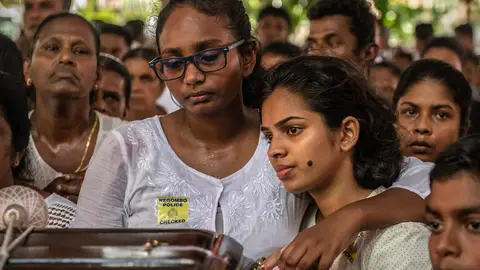What We Know About The Bombings In Sri Lanka — And How To Help

By Christianna Silva
A devastating wave of bombings killed more than 300 people and injured hundreds more in Sri Lanka on Easter Sunday, in one of the world’s deadliest terrorist attacks since 9/11 and the worst violence Sri Lanka has seen since its 26-year civil war came to an end a decade ago.
It’s unclear exactly how the attacks were carried out, but the Associated Press reported that they were likely the result of suicide bombers who conducted attacks at three Roman Catholic churches and three five-star hotels. Two bombings – one at a guesthouse and another at an attacker's safe house – remain under investigation, according to the New York Times. Three police officers were reportedly killed in one of the last two blasts, which reportedly took place when a suspect detonated a bomb while he was being questioned, according to The Cut.
What we know about the victims
On Tuesday morning, the death toll of the attacks has risen to 310, according to the Guardian. The majority of the deaths were Sri Lankan families, workers, honeymooners, and children.
Mary Otricia Johnson, a Sri Lankan mother at mass, was one of the victims. Her daughter told the New York Times that the ambulance attendants were too overwhelmed to take her mother to the hospital; she later died in an auto-rickshaw from internal bleeding.
A Sri Lankan restaurant attendant, Ravindran Fernando, died while attending mass. Shantha Mayadunne, a chef with a TV show who taught classes focused on “quick and easy” meals, died with her daughter at the Shangri-La Hotel in Colombo.
“Even if you have a stable income, and every comfort in the home, there is nothing that can bring a greater feeling between family members than a satisfying meal,” she said in a 2001 interview per the New York Times.
Two Turkish engineers, an entire Sri Lankan family, and a Bangladeshi politician’s young relative were also among those killed, the New York Times reported.
Almost 40 of the victims were foreigners from Australia, Britain, China, Japan, Portugal and the U.S., Sri Lankan tourism minister, John Amaratunga confirmed to the New York Times. Danish billionaire Anders Holch Povlsen of ASOS lost his three children. A fifth-grader from Washington D.C’s elite private school, Sidwell Friends, was also killed, according to NBC Washington.
What we know about the attackers
On Monday, the Sri Lankan government said a little-known religious extremist group was to blame for the attacks and said the group received help from “an international network,” according to Rajitha Senaratne, Sri Lanka’s health minister, per the New York Times.
The group is best known for being anti-Buddhist and has been linked to vandalizing Buddhist statues. (According to Pew Research Center’s Religion & Public Life Project, 69 percent of Sri Lankans are Buddhist, 13 percent are Hindi, 9 percent are Muslim and 7 percent are Christian.)
It’s important to note that no person or group has actually come forward to admit culpability for the attacks yet. Two dozen people have been detained in connection with the attacks.
There are currently no known ties between this attack and the Islamic State, according to the New York Times.
As Intelligencer reports, the country also issued a social media blackout after the attacks in an effort to curb the spread of conspiracy theories and misinformation. There is currently no known social component to the attacks, but authorities blocked civilian access to Facebook, Instagram, Viber, and WhatsApp shortly after the attacks; the Guardian notes that this kind of practice is becoming more and more common in the area following wide scale public violence.
What we know about the alleged missed warning
About two weeks before the attack, Sri Lankan authorities received warnings that the extremist group was planning an attack on churches, but authorities failed to act on the information, the New York Times reported.
“Fourteen days before these incidents occurred, we had been informed about these incidents,” Rajitha Senaratne said during a press conference in Colombo, Sri Lanka on Monday, according to the Guardian.
Prime Minister Ranil Wickremesinghe said he hadn’t been briefed about the warning, saying that it could have been the result of ongoing tensions between him and President Maithripala Sirisena, who is also the defense minister, according to the New York Times.
“We must look into why adequate precautions were not taken,” Wickremesinghe said on Sunday.
What you can do to help
There are plenty of ways to help the victims and survivors of the attack. If you have extra funds, consider donating to the Sri Lanka Red Cross and Asia Pacific Red Cross, which would fund those helping in the aftermath. Kind Hearted Lankan's Charity opened up a GoFundMe page to assist with their groundwork at hospitals, including helping buy towels, mattresses, bedsheets, clothes, and toiletries. There are at least a dozen other campaigns seeking donations on GoFundMe, but none of them are verified yet, so donate with caution.
If you’re near Colombo, or have the means to go to Colombo, you can volunteer with nonprofits like Volunteer Sri Lanka or give blood to the Sri Lanka National Blood Transfusion Service, which is looking for donations, according to the India Times.





